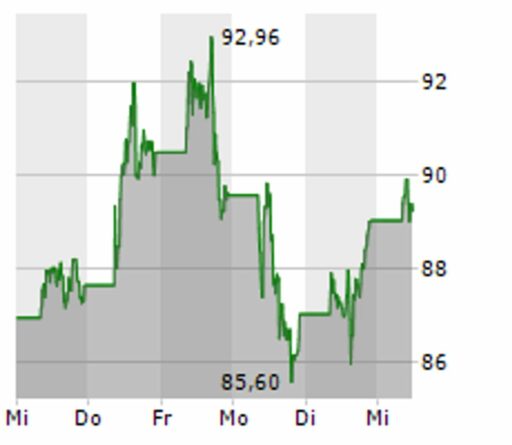Taiwan Semiconductor Manufacturing Company Limited (TSM) has been a focal point for investors seeking growth in the semiconductor industry. With its robust market presence and potential for dividend income, TSM stock presents a compelling investment opportunity. This guide delves into the market potential of TSM stock by examining its growth trajectory, dividend prospects, comparative market position, and strategic investment approaches, while also considering the company’s sustainability and corporate responsibility.
Key Takeaways
- TSM stock shows promising growth potential with an anticipated increase of 46.52%.
- TSM’s dividend yield stands at 1.71%, which is competitive within the US market but lower than the top dividend payers in the technology sector.
- The TSM Dividend Calculator is a valuable tool for investors to forecast potential returns from dividends based on their investment size.
- TSM holds a Zacks Rank #3 (Hold), indicating it may perform in line with the broader market in the near term.
- TSM’s sustainability score is favorable at 100%, reflecting the company’s commitment to responsible practices.
Assessing the Growth Trajectory of TSM Stock

Understanding the Market Dynamics
To fully grasp the potential of TSM stock, investors must consider the intricate market dynamics that influence its performance. Market momentum and performance indicators provide valuable insights into the stock’s current standing and future direction. For instance, volume leaders and price volume leaders are critical metrics that reflect trading liquidity and investor interest.
In the context of TSM, recent data indicates a notable decline in revenues, yet the company forecasts a robust recovery. The following table summarizes TSM’s recent financial performance and projections:
| Year | Revenue Change | Projected Growth |
|---|---|---|
| 2023 | -8.7% | – |
| 2024 | – | Low-to-mid 20% |
This projection is particularly significant given the competitive positioning of TSM in the semiconductor industry. With emerging market trends shaping the sector, TSM’s ability to capitalize on these changes will be crucial for its growth trajectory.
Investors should remain vigilant of the long-term trends and price surprises that could signal shifts in market sentiment and opportunities for strategic positioning.
Evaluating Historical Performance and Future Projections
When assessing the investment potential of TSM stock, a thorough evaluation of its historical performance and future projections is essential. The company’s forward 12-month consensus EPS estimate reveals a trajectory that investors should consider. This estimate, coupled with projected revenue growth, provides a clearer picture of TSM’s financial health and growth potential.
Valuation is a cornerstone in predicting a stock’s future price performance. It’s crucial to determine if the current price reflects the intrinsic value of the business and its growth prospects.
Revisions to earnings estimates are particularly telling. At Zacks, the change in the projection of a company’s future earnings is seen as a key indicator of stock value. This is because the present value of its future earnings stream is what ultimately determines the fair value of its stock. Additionally, comparing valuation multiples such as P/E, P/S, and P/CF with historical values and peers can help investors decide if TSM stock is fairly valued, overvalued, or undervalued.
| Valuation Metric | Current Value | Historical Average | Peer Comparison |
|---|---|---|---|
| P/E Ratio | X | Y | Z |
| P/S Ratio | A | B | C |
| P/CF Ratio | D | E | F |
Understanding the market dynamics and how they influence TSM’s performance is also crucial. The Market Digest snippet indicates that broader economic indicators, such as the Consumer Price Index, can have an impact on stock prices, including those of TSM.
Analyzing Industry Trends and Competitive Positioning
In the semiconductor industry, where TSM operates, staying ahead of trends and maintaining a competitive edge are crucial for success. The industry is characterized by rapid technological advancements and high capital expenditures. Companies that can innovate and scale efficiently tend to dominate the market.
- Top Signal Strength
- Top Signal Direction
- Stock Signal Upgrades
These indicators reflect the market’s perception of a company’s performance relative to its peers. TSM’s position can be gauged by analyzing these signals in the context of industry heat maps and performance rankings.
TSM’s ability to consistently invest in research and development and to expand its manufacturing capabilities has been a key factor in its competitive positioning.
The table below summarizes TSM’s industry ranking and performance metrics:
| Metric | TSM Ranking | Industry Average |
|---|---|---|
| Signal Strength | High | Moderate |
| Signal Direction | Upward | Stable |
| Performance | Leading | Competitive |
Understanding these metrics provides investors with a snapshot of TSM’s standing in the semiconductor sector and its potential for growth.
Dividend Analysis and Reinvestment Opportunities

Breaking Down TSM’s Dividend Yield and Payout Ratio
To fully grasp the dividend performance of TSM, it’s crucial to analyze the historical payout ratios in relation to the company’s earnings. The dividend yield currently stands at 1.71%, with the most recent quarterly payment being $0.489 per share on October 12, 2023. This yield reflects a decrease of 17.59% from the previous year, indicating potential shifts in the company’s dividend policy or earnings stability.
| Date | Dividend Per Share | Dividend Yield (TTM) | Payout Ratio (TTM) |
|---|---|---|---|
| Sep 14, 2023 | $0.489 | 1.71% | Not Available |
| Next (Projected) | $0.370 | Expected Increase | Not Available |
While the dividend yield is a key indicator of the income generated from an investment in TSM, the payout ratio provides insight into the sustainability of these dividends. A lower payout ratio generally suggests that the company retains more earnings for growth, which could lead to higher future dividends or reinvestment in the business.
The upcoming ex-dividend date is set for March 18, 2024, with the subsequent payment date on April 11, 2024. Investors considering TSM for its dividend prospects should also utilize the TSM Dividend Calculator to forecast potential returns based on individual investment size or share count.
Exploring the Dividend Reinvestment Plan (DRIP)
The Dividend Reinvestment Plan (DRIP) offered by companies like TSM allows shareholders to automatically reinvest their cash dividends into additional shares, often without any transaction fees. This can be a powerful tool for investors looking to compound their holdings and benefit from the potential for long-term growth.
For those interested in TSM’s DRIP, it’s essential to check with your brokerage for the availability and specifics of the plan. Here’s a quick rundown of what you might expect:
- Enrollment in the DRIP is usually straightforward, often requiring just a few clicks in your brokerage account.
- Dividends are reinvested on the dividend payment date, purchasing additional shares at the current market price.
- Some DRIPs offer the option to purchase additional shares at a discounted price, enhancing the investment value.
TSM’s strong Dividend Sustainability Score indicates a robust capacity to maintain current dividend levels, while the Dividend Growth Potential Score suggests the likelihood of future dividend increases.
Investors should consider the DRIP as part of their overall investment strategy, especially if they are focused on long-term growth and income. The reinvestment of dividends can significantly impact the total returns over time, making it a consideration worth exploring.
Utilizing the TSM Dividend Calculator for Investment Planning
The TSM Dividend Calculator is a powerful tool for investors looking to understand the potential returns from their TSM stock dividends. By inputting either the total investment amount or the number of shares owned, the calculator provides a projection of cumulative dividend payments over a chosen period.
The calculator’s forecast can help investors plan their reinvestment strategies and anticipate cash flows from dividends.
For those interested in the Dividend Reinvestment Plan (DRIP), it’s essential to verify with your brokerage if TSM offers this option, as it allows for automatic reinvestment of dividends into additional shares.
Here’s a quick glance at TSM’s recent dividend figures:
| Date | Dividend Per Share | Dividend Yield (TTM) | Next Ex-Dividend Date |
|---|---|---|---|
| Oct 12, 2023 | $0.489 | 1.71% | Mar 18, 2024 |
Understanding the historical dividend payout ratios and their correlation with the company’s earnings is crucial for assessing TSM’s dividend performance. Notably, TSM pays dividends quarterly, with the last amount being $0.489.
Comparative Analysis: TSM Versus Peers and Sectors
Benchmarking Against Competitors and Market Leaders
When evaluating TSM’s position in the semiconductor industry, it’s crucial to benchmark its performance against competitors and market leaders. TSM’s robust market presence and consistent growth make it a formidable player, but how does it stack up against peers like LRCX? According to StockNews, TSM has an overall rating of B, which suggests a Buy recommendation in their POWR Ratings system. In contrast, LRCX holds a rating of C, indicating a more cautious stance.
The comparison of TSM to its peers is not just about ratings; it involves a deep dive into financial health, market share, and innovation capabilities.
To illustrate the competitive landscape, consider the following table which encapsulates key metrics:
| Metric | TSM | LRCX |
|---|---|---|
| Market Capitalization | $XXX Billion | $XXX Billion |
| P/E Ratio | XX.X | XX.X |
| Dividend Yield | X.X% | X.X% |
This snapshot provides a clear view of where TSM stands in relation to LRCX, offering investors a quantitative basis for comparison. It’s essential to look beyond the numbers and understand the strategic moves and technological advancements that drive these figures.
Sector Comparison: Technology Dividend Payers
When comparing TSM to other technology dividend payers, it’s essential to consider the dividend yield in relation to market capitalization and sector averages. TSM’s dividend yield of 1.71% is commendable, yet it falls short when stacked against the top dividend payers within the technology sector.
The table below provides a snapshot of how TSM stands alongside its competitors in terms of dividend yield and payout ratio:
| Symbol | Company Name | Market Cap | Dividend Yield (TTM) | Payout Ratio (TTM) |
|---|---|---|---|---|
| IBM | International Business Machines | $175.768B | 5.07% | 80.51% |
| FIS | Fidelity National Information Services Inc | $40.209B | 3.24% | -18.50% |
| TSM | Taiwan Semiconductor | $644.105B | 1.71% | 34.79% |
| SAP | SAP SE | $226.243B | 1.64% | 37.11% |
| ORCL | Oracle | $350.597B | 1.51% | 30.74% |
| ACN | Accenture plc | $234.006B | 1.51% | 42.61% |
| SONY | Sony Corp Ord | $106.756B | 0.433% | 10.84% |
While TSM’s dividend yield is higher than some of its peers, it is crucial to analyze the sustainability of these dividends and the potential for growth. Investors should also consider the overall financial health of the company and the industry’s future outlook.
In the broader market context, TSM’s performance is also influenced by country-specific factors and market sentiment, which can affect investor decisions.
Country-Specific Performance and Market Sentiment
When evaluating TSM’s stock performance, it’s crucial to consider the country-specific factors that can significantly influence market sentiment and investment decisions. Taiwan, as TSM’s home base, plays a pivotal role in shaping the company’s market performance.
Investors often look at the broader economic indicators and policy decisions within Taiwan to gauge potential impacts on TSM’s operations. For instance, currency fluctuations, trade policies, and regional geopolitical tensions can all affect investor confidence and stock prices.
The interplay between local market conditions and TSM’s stock performance underscores the importance of a nuanced, regionally informed investment approach.
Here’s a snapshot of TSM’s recent performance in different regions:
| Region | Q1 Performance | Market Sentiment |
|---|---|---|
| Taiwan | +5% | Stable |
| Europe | -2% | Cautious |
| USA | +3% | Optimistic |
This table illustrates the varying performance and sentiment across key markets, highlighting the need for investors to monitor regional trends closely.
Investment Strategies for TSM Stock

Navigating Market Trends and Analyst Ratings
Investors seeking to capitalize on TSM stock must stay attuned to market trends and analyst ratings, which serve as vital indicators of the stock’s potential trajectory. Nasdaq Analyst Research, for instance, provides a summary of stock price targets and a consensus on ratings, reflecting the collective judgment of experts on the stock’s expected performance.
- Top Signal Strength
- Top Signal Direction
- Stock Signal Upgrades
These elements are crucial for understanding the market’s sentiment towards TSM. Additionally, keeping an eye on industry heat maps and rankings can reveal how TSM stands in comparison to its peers, offering insights into its competitive positioning.
By closely monitoring these signals, investors can make more informed decisions, adjusting their strategies to align with the prevailing market conditions.
Incorporating Earnings Estimates and Zacks Rank into Decision Making
When considering TSM stock for your portfolio, it’s crucial to integrate earnings estimates and the Zacks Rank into your analysis. Revisions to earnings estimates are a central component of the Zacks Rank, reflecting changes in business conditions and analyst expectations. The Zacks Rank, ranging from #1 (Strong Buy) to #5 (Strong Sell), offers a predictive measure of a stock’s near-term price movements.
The Zacks Rank is updated frequently, ensuring its relevance and timeliness in reflecting the latest analyst revisions and market trends.
Here’s a simplified breakdown of the Zacks Rank system:
- Zacks Rank #1 (Strong Buy)
- Zacks Rank #2 (Buy)
- Zacks Rank #3 (Hold)
- Zacks Rank #4 (Sell)
- Zacks Rank #5 (Strong Sell)
By cross-referencing the Zacks Rank with other analytical tools such as the Average Broker Rating (ABR), investors can gain a more comprehensive view of the stock’s potential. It’s important to note that the Zacks Rank is distinct from the ABR, with the former being more current due to continuous updates from brokerage analysts.
Building a Diversified Portfolio with TSM Holdings
Incorporating TSM into a diversified portfolio can help mitigate risk and capitalize on the company’s growth potential. Exchange-traded funds (ETFs) offer a straightforward way to achieve this diversification. By investing in a single ETF, you expose your portfolio to a variety of securities, including TSM stock.
When considering TSM for your portfolio, it’s important to compare its dividend yield and payout ratio with other technology sector dividend payers. TSM’s solid dividend yield of 1.71% is a key factor for income-focused investors.
For those interested in the Dividend Reinvestment Plan (DRIP), TSM may provide an option to automatically reinvest dividends to purchase additional shares. This can be an effective strategy to compound your investment over time. Please consult with your brokerage to confirm the availability of such a plan.
Here’s a quick comparison of TSM’s dividend yield and payout ratio with its competitors:
| Symbol | Company Name | Dividend Yield (TTM) | Payout Ratio (TTM) |
|---|---|---|---|
| TSM | Taiwan Semiconductor | 1.71% | 34.79% |
| IBM | International Business Machines | 5.07% | 80.51% |
| FIS | Fidelity National Information Services Inc | 3.24% | -18.50% |
| SAP | SAP SE | 1.64% | 37.11% |
| ORCL | Oracle | 1.51% | 30.74% |
| ACN | Accenture plc | 1.51% | 42.61% |
| SONY | Sony Corp Ord | 0.433% | 10.84% |
Sustainability and Corporate Responsibility

Understanding TSM’s Sustainability Score
TSM’s commitment to sustainability is reflected in its perfect Sustainability Score of 100.00%, indicating a strong alignment with environmental and social governance criteria. This score is a testament to the company’s dedication to maintaining high standards of corporate responsibility.
The company’s robust Dividend Sustainability Score (DSS) complements its sustainability efforts, showcasing its ability to sustain current dividend levels while signaling potential for future growth.
In the context of investment, TSM’s sustainability initiatives may influence investor confidence and contribute to the stock’s long-term value. The following table summarizes key sustainability-related scores:
| Score Type | Value |
|---|---|
| Sustainability Score | 100.00% |
| Dividend Sustainability Score (DSS) | Good |
| Dividend Growth Potential Score (DGPS) | Increase likely (46.52%) |
Investors are increasingly factoring in sustainability scores when making investment decisions, and TSM’s strong performance in this area could be a significant draw.
The Impact of Corporate Governance on Investment
Corporate governance plays a pivotal role in shaping investor confidence and the long-term success of a company. Strong corporate governance can lead to enhanced investment efficiency, ensuring that resources are allocated in a manner that maximizes shareholder value. A study highlights the significant impact of corporate governance on investment efficiency through audit quality in Pakistani firms, underscoring the broader implications for global markets.
Investors often consider corporate governance as a critical factor when evaluating a company’s prospects. It is not just about compliance with regulations; it’s about creating a culture of transparency, accountability, and ethical decision-making. These elements contribute to a company’s reputation and can have a direct effect on its stock performance.
The valuation of a stock is incomplete without considering the effectiveness of its corporate governance. It is a fundamental factor that drives the buy-and-hold decision for long-term investors.
While immediate market trends can influence stock prices, it is the underlying corporate governance framework that often determines the sustainability of a company’s growth and profitability.
Aligning Investment Choices with Ethical Standards
Investors are increasingly considering the ethical implications of their investment choices, and Taiwan Semiconductor Manufacturing Company Limited (TSM) stands out as an ethical company with integrity. TSM’s commitment to sustainable cash dividends reflects its core values of Integrity and Commitment, aligning with the interests of investors who prioritize corporate responsibility.
When evaluating TSM stock, investors should consider how the company’s ethical standards and sustainability practices may influence its long-term performance and brand reputation.
By integrating ethical considerations into investment strategies, investors can support companies that contribute positively to society while potentially enhancing their own financial returns. It’s a win-win scenario that balances profit with principles.
Conclusion
In summary, Taiwan Semiconductor Manufacturing Company Ltd. (TSM) presents a compelling case for investors, with a notable growth potential of 46.52% and a sustainability score of 100%. While TSM’s dividend yield of 1.71% is higher than the bottom quartile of US dividend payers, it falls short of the top dividend payers in the technology sector. The Zacks Rank #3 (Hold) indicates that TSM may perform in line with the broader market in the near term, suggesting a cautious approach for those considering an investment. The availability of tools like the TSM Dividend Calculator and the option for dividend reinvestment plans (DRIP) provide additional avenues for investors to maximize their returns. As the semiconductor industry continues to evolve, TSM’s market position and financial metrics should be monitored closely to identify the right investment opportunities.
Frequently Asked Questions
What is the growth potential of TSM stock?
The growth potential for TSM stock is considered to be likely to increase, with a projected rise of 46.52%.
How does TSM’s dividend yield compare to its sector and the market?
TSM’s dividend yield of 1.71% is higher than the bottom 25% of dividend payers in the US market (0.472%) but lower than the top 25% of dividend payers in the Technology sector in the US market (6.80%).
Can dividends from TSM stock be automatically reinvested?
If TSM offers a Dividend Reinvestment Plan (DRIP), shareholders may have the option to automatically reinvest dividends to purchase additional shares. Please check with your brokerage for the availability and details of such a plan.
Is TSM stock a buy according to Zacks Equity Research?
TSM stock is one of the stocks watched by Zacks.com visitors lately, and while it’s trading at a premium to its peers, it has a Zacks Rank #3 (Hold), suggesting it may perform in line with the broader market in the near term.
How can I use the TSM Dividend Calculator for investment planning?
The TSM Dividend Calculator is designed to forecast the potential returns from TSM dividends based on your individual investment size or the number of shares you own. Enter your total investment amount to see the cumulative dividend payment you could receive over a specified period.
What is TSM’s sustainability score and why does it matter?
TSM’s sustainability score is good (100.00%), which is important as it reflects the company’s commitment to environmental, social, and governance (ESG) criteria, which can be a consideration for ethically-minded investors.





